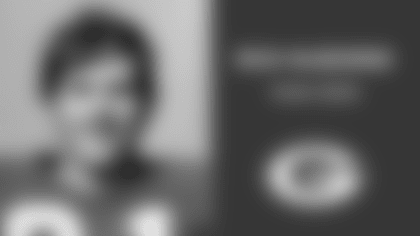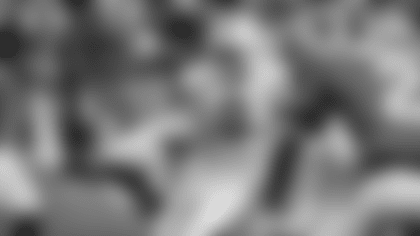Bringing In 'Da Noise
James Taylor was in concert across the street at the Resch Center, but he probably didn't top the decibel levels in the Don Hutson Center this week. And chances are good that John Mellencamp won't two weeks from now either.
No, this week the crowd noise that blared inside the Packers' indoor practice facility would have made Marilyn Manson envious. Packers GM/Head Coach Mike Sherman called it "deafening."
If unpleasantly loud, that's the point. Because if past meetings are any indication, such will be the conditions inside the Metrodome this Sunday.
"After that game, I usually have a headache," Packers guard Marco Rivera admitted.
It's probably not just from the crowd noise. In the past 10 years, the Packers have won only twice at the Metrodome. And while there have been a variety of factors at work in those losses, screaming fans underneath a closed roof have certainly played a role, forcing the Packers to work from silent counts on offense, which reduce the margin for error.
In last year's meeting, center Mike Flanagan twice snapped the ball over Brett Favre's head in the shotgun formation. Earlier this season, the Packers' suffered a similar mishap at the Louisiana Superdome, when Frank Winters snapped the ball to Favre prematurely, resulting in a fumble.
The Packers insist that working off a silent snap isn't rocket science, but it doesn't make life any easier.
"It's just something different," Flanagan said. "This is such a business of repetition, doing the same thing every day. When you do that, it changes it up a little bit."
Said Rivera, "When you've got to wait for the ball to be snapped, that kind of levels out the playing field and kind of gives the advantage back to the defense, because they're looking right at the ball and they're going as soon as the ball moves."
By pumping crowd noise into practices this week, Sherman is hoping that by Sunday the Metrodome might feel just like home.
"It will not be any louder over there than (in the Hutson Center), except that it's a game and not a practice," Sherman said. "That will be the real difference, is that the live bullets will be flying."
Ultimately, it comes down to how the game is played. The Packers might have a less than impressive record in Minneapolis over the last decade, but they have demonstrated that they can win there. It's just a matter of doing so.
"My history as head coach here is we're 1-1 in the dome," Sherman said. "Last year we didn't play very well. We can attribute that to the dome, or attribute that to the Minnesota Vikings outplayed and out-coached us, which is what I feel.
"I look at it as a challenge to go over there. We've won here at home at Lambeau Field and that is nice, and now the opportunity exists for us to challenge our football team to go into a dome environment, which maybe hasn't been as friendly to us as outdoors.
"I think that's a challenge we have to face, and I look forward to it."
Minnesota Misery
Minnesota head coach Mike Tice has heard it said before that when the Packers and Vikings meet, you can throw out the records.
Earlier this week, he said there was nothing he'd like to do more.
With a 2-7 record, the Vikings are off to their worst start since 1984. Not exactly the debut Tice hoped to make in his first full season as head coach.
"I haven't been associated with many losing teams in my years in the National Football League and this is tearing a hole in me," Tice said. "It's been very tough."
Just like the Packers have thrived by winning the turnover battle, losing the takeaway war has been the Vikings' undoing. With 26 turnovers compared to 10 takeaways, the Vikings are minus-16 on the turnover ratio, compared to the Packers' plus-15 mark.
Yet in the face of his team's woes, Tice said he has not lost confidence in his ability as a head coach. He's convinced the Vikings' current system can produce a winner in Minnesota, even if it isn't this season.
But that doesn't mean he's without regret.
This offseason, Tice proposed the 'Randy Ratio,' a theory he hoped would allow the Vikings to ride the talent of one of the best receivers in the league, Randy Moss, to a winning season.
Tice had noticed that the Vikings won 80 percent of the games in which Moss was the target on 40 percent of the team's passing plays. Thus, Tice hoped to give Moss a steady diet of plays throughout the game to see to it that the 40-percent plateau was met.
As dangerous as it looked on paper, it wasn't nearly as fruitful on the field. In fact, Tice admitted, it probably had a negative effect on quarterback Daunte Culpepper, who was shouldered with the responsibility of getting Moss his looks, often at the expense of the natural 'flow' of the game.
In addition to five fumbles lost, Culpepper has tossed 14 interceptions this season, compared to only eight touchdown passes.
"I've been on the record saying the Randy Ratio probably screwed him up a little bit early in the season," Tice said of Culpepper. "We kind of discarded the Randy Ratio right around the bye and decided that we were going to be more patient with what we were trying to accomplish. I think it's helped some."
Save the turnovers, the Vikings' offense has been solid this season. While they trail the Packers slightly in terms of total passing yards (2,231 to 2,031), they lead Green Bay in terms of first downs (197 to 185) and total rushing yards (1,377 to 1,124).
And even with the Randy Ratio discontinued, shutting down Moss -- currently the NFC's sixth-leading receiver with 56 receptions for 649 yards and three touchdowns -- will be among the Packers' leading concerns.
"I think if you can keep Randy out of the end zone, you've done very well," Packers GM/Head Coach Mike Sherman said. "He's such an explosive player. I don't think you can get caught up in the amount of catches that he has, but you have to try like heck to keep him out of the end zone. And that's a daunting task, obviously."
Rest Rewarding
It's been almost four weeks since Brett Favre suffered a sprained lateral collateral ligament against the Washington Redskins. And while he admitted Wednesday that he'd like to lose the bulky protective knee brace that he's worn in his past two starts, it's unlikely to happen this week, especially when Sunday's date is with the artificial turf of the Metrodome.
"I would love to go without it," Favre said Wednesday. "Being that it's artificial turf (and) I can still feel (the injury) a little bit, might as well wear it. Like I said after the game, it doesn't restrict it, it's just more or less getting used to it."
For the second straight time, Favre sat out Wednesday's practice this week. While reluctant to stand on the sidelines, as a result Favre has seen positive effects for more than just his ailing knee.
"Anytime you miss practice, I think you're missing out on something," Favre said. "I understand why I need to do it. You weigh it. Am I going to get better today as opposed to maybe hurt the injury, or just aggravate it some? I think it's more positive than negative sitting out.
"The other thing I think is forgotten, and I've realized this in the past couple weeks, is when I come back and throw Thursday, my arm feels much better. Even though there's nothing wrong with it, just with the extra day of rest I feel like I'm a 22-year-old rookie again. It's amazing what one day of not throwing can do."
Who's No. 2?
Behind halfback Ahman Green, the Packers have a pair of promising backups in Najeh Davenport and Tony Fisher, but GM/Head Coach Mike Sherman refused to label either of the rookies the No. 2 halfback this week.
That might come as a surprise to some, since Davenport (39) has 20 more carries than Fisher (19). But it can't be forgotten that Davenport carried the ball 22 times at Detroit, in relief of an injured Green. That game notwithstanding, the numbers are fairly balanced.
Sherman said he has confidence in both backs. He labeled Davenport as perhaps the more dangerous ball carrier for his ability to run both over and around potential tacklers. Fisher, on the other hand, is the better pass-protection blocker, and possesses better hands, Sherman said.
"I wouldn't classify one ahead of the other," Sherman said. "They both have their strengths and weaknesses at this point. Particularly since they both put the ball on the ground the other day (against Detroit), they both have their weaknesses.
"If one had (turned the ball over) and one had not, that would have been an easy call. But they both did, so it's a little bit tough."














